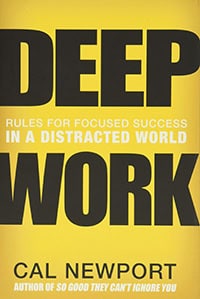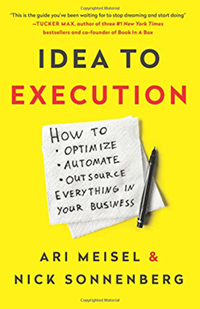In this Episode
- [01:22]Nick starts things off by discussing how to gain leverage, which he explains is a topic that applies to both your business life and your personal life. He then goes through some of his favorite hacks for getting time back.
- [04:12]Stephan digs into the concept of inbox zero that Nick brought up. Nick then offers his advice for managing email.
- [09:30]In response to Nick’s advice to filtering some things straight to your archive, Stephan points out that he receives some things from mailing lists that he really needs to see. Nick then offers his advice for this situation.
- [11:57]It’s very tough to find someone you trust enough to manage your email for you, Nick points out. He then goes into more details about options for managing your inbox.
- [14:24]The best way to get to inbox zero is to get to email zero. Nick offers some strategies for doing this.
- [16:04]What’s the difference between using Slack to communicate with your team as opposed to a tool like Asana or Trello or Basecamp?
- [19:14]Stephan just recently switched from Trello to Asana.
- [21:16]What sort of trusted systems does Nick use or recommend? And how is he keeping track of his bookmarks?
- [25:21]Nick talks about how he battles attention residue. He explains that he assigns general themes to his days.
- [29:02]We hear about Nick’s forthcoming project management software and why it’s better than Trello.
- [33:26]Nick clarifies what a kanban system or workstyle is. The typical flow is that you dump everything that needs to get done into a backlog, then move it from the backlog stage to the doing stage, then from the doing stage to the done stage.
- [35:32]Nick discusses using a virtual assistant to get some of your time back by delegating tasks that don’t require you to do them yourself. He also goes into depth about what his company does, which is far more than just simple research and email management.
- [38:48]How does the pricing for Nick’s company, Leverage, work?
- [41:08]Is Nick using any sort of screenshotting tool to make sure that his contractors are being honest about their time?
- [43:32]Nick talks about some other apps that his business uses and discusses his use of GitHub instead of Trello.
- [47:11]Nick lists some ways to get in touch with his company if you’ve decided you want to work with them.
Transcript
Nick, it’s great to have you on the show.
Thanks for having me.
Let’s talk about how to gain leverage. That is the name of your company. What are some of the best ways? I’m guessing that having virtual assistance or some sort of team of people that you can delegate to is part of the equation. Let’s hear from you on how to gain leverage.
For us at Leverage, it’s about work-life integration, time is time.
For me, there’s not just one magic pill here, it’s a mentality and having systems in place to delegate and automate various things in both your personal life and your business life. There’s a big mental aspect to it too because a lot of people separate business life from personal life. For us at Leverage, it’s about work-life integration, time is time. Figuring out hacks or tricks or ways that you can save time whether it’s business or personal, it doesn’t really matter for us, time is time.
What are some of your favorite hacks for paying some of your time back?
At Leverage, we’re a virtual assistant company, delegating things that you’re not uniquely talented to do or things that are a time suck. Getting those off of your plate is a really easy win. Automation is another one. There’s literally hundreds or thousands of things you do on a daily basis. The more that you can automate, even if it’s a three-second thing, just getting that out of your head so that you don’t have to worry about it anymore really ends up adding up to a lot of mental clarity and time-saving. I think David Allen has a good phrase, that your brain is having ideas, not holding ideas. As much as possible, you can get rid of the things out of your head into systems or give them to people or give them to automation scripts to do for you, the better off you’ll be. Another huge thing is the proper use of email. One thing that my partner, Ari Meisel, and I always find companies and individuals struggle with are communication and managing projects. We do a lot of business consulting, in the past, we have done that, we’re trying to move away from that a bit. From everyone that we’ve worked with, everyone has trouble with email, everyone thinks that they do email right because they have email read zero instead of email inbox zero. How you communicate, both with your team, with clients, doing that in an efficient way, and getting to inbox zero is huge. Aside from that too, if you’re running a business, properly managing tasks, and having a system in place to manage what needs to get done by whom is another huge key to the puzzle. A lot of people that we’ve met with, they run their companies off with text and email to manage, sometimes, teams that are in hundreds. Communication, project management, systems, virtual assistance, and automation would be four big categories that I would suggest people to really take a close look at.

We’ll dive a bit more into each of those in just a few minutes. One thing I wanna jump into here is this concept of inbox zero. I think a lot of people do get it wrong. I actually asked David Allen on the episode where I had interviewed him, that was episode 26 on Get Yourself Optimized, great episode, I was getting overwhelmed with my inbox and it felt like it could never get caught up. What he suggested to me was to have a demilitarized zone, create a folder called DMZ and drag everything that’s in my inbox into that and then start fresh. That was a huge saving grace for me to be able to do that rather than try and get caught up because I was never getting close to getting caught up, I get hundreds of emails a day. Eventually, I never cleared out that DMZ zone but it didn’t really matter, I just didn’t need it, it was okay. Eventually, that stuff got really old and I just dumped it all unto the archives and I didn’t have a DMZ folder from that point on. Any other magic bullets that you would recommend to our listeners for managing email?
I’ll split up my suggestion into two parts, one will be more theoretical and then one will be specific to current day’s technology which, as you know, is changing fast. What I suggest now in terms of what email system to use, that could change in six months from now, who knows. As a more general concept for emails, like David suggested to you, for sure, any email that’s more than two weeks old is most likely not super important right now so you can move those out of your inbox. Your inbox should be used as a to-do-list. Anything in your inbox should be things that you can deal with right now. If you can’t deal with it right now, it shouldn’t be there. For us, we have a system with three Ds, you deal with it, that’s in your inbox. If you can’t deal with it or you don’t want to deal with it right now, let’s say directions to a doctor’s appointment for this Thursday, that doesn’t need to sit in your inbox right now.
You should snooze it so it goes out of your inbox but comes back to your inbox on Thursday, when it’s relevant. Likewise, if you structure your workweek in a way where Mondays are your days for doing BS Accounting type of things or tasks that you don’t really love, snooze all of the relevant emails to Monday. If Wednesday are your days for speaking to prospects or clients, any prospect or client email, snooze that to Wednesday. Creating your work week and snoozing things to relevant days is huge. You have a deal, that was the first. Delete or archive is the third D. Anything that you don’t need that isn’t important anymore, just archive. The email provider that we suggest is Google, Google has Inbox by Google which is their new design of Gmail. That comes with snoozing built into it and bundling. You can snooze emails and it’s for free, in the past, you used to have to pay for followup.cc or follow-up then, now this is free, built right into Gmail. You can just really nicely snooze to whatever date and time you want.
What I suggest is, you use Inbox by Google, your inbox is for things that you need to do and then you archive everything else. Just like David, he suggests creating that DMZ folder, for us we don’t suggest that, we just say, “Go ahead and just straight archive so you’re not deleting anything, it’s still there, it’s just in the done folder in Gmail rather than being in your inbox.” You have an inbox and done, basically. Another nice thing with Inbox by Google is they bundle things. If you make a purchase, there’s a bundle of purchases. In one shot, you have this thread of emails that are packaged into the finance or the purchase bundle and you can quickly look through them. If you don’t need any of them, you can just click one archive button and it’ll archive the whole bundle.
Especially if you’re getting a couple of hundred emails a day, there’s a bundle for updates, there’s the bundle for low priority, etc. You can just click one button and archive them straight away. I look at my inbox multiple times a day and then I’ll check my archives a couple of times a day and maybe a couple of these bundles a couple of times a day. Another trick which is huge is, in Gmail, you can set up filters. I would suggest going into the settings of Gmail, go to filters, and any email that has the word unsubscribe, opt-in or things of that nature, I can provide you a string, we have a string of 50 different words, but things of that nature, unsubscribe, opt-in, skip the inbox and automatically archive. You don’t need to have those extra plugins or companies that people really suggest like SaneBox or Unroll.Me. If you like them, great. If you just do proper filtering to skip inbox and archive, they won’t even hit your inbox in the first place.
That’s a cool tip. The thing is, though, I’m subscribed to some things that I really need to see. If they go directly to my archive, then I’ll probably never go in there and look at them.
We’re not deleting, we’re archiving. This is just the separation of what needs more of my attention and less of my attention.
You have to condition yourself to check your archive once or twice a day, still. Again, we’re not deleting, we’re archiving. This is just the separation of what needs more of my attention and less of my attention. Something with those words in it, odds are that they don’t require your attention as much as you would from a client or something like that. We’re just trying to keep you focused with things that have the highest probability of needing your attention right now. You just train yourself; check your inbox ten times a day, check your archive twice a day.
I’d love to get that string of the list of texts to filter by. I’ll just briefly explain my approach to handling my email so that I stay at inbox zero and it involves a virtual assistant. I have a trusted virtual assistant who has access to my main email account and that includes personal emails as well as business emails. She will filter stuff and file stuff, I have filter setup automatically as well, I’m using Google’s mail system as well. For those people who don’t realize this, Google allows you to use your own domain. The Google App Services allows you to use your own domain for your email and it’s all based on the Gmail system. I’ve got filter setup, I have all sorts of cool tech integrated into that. Still, I have somebody managing my email for me. That helps me stay at inbox zero, I have a folder called action or at action, I have a folder called read review and one for archives and another app waiting for and another at someday maybe. I’ll just go into my action folder and my read review folder and not worry about what’s in my inbox. That’s a little different and it requires a great deal of trust to have somebody who works for you that has the keys to the kingdom. Is that something that you run across very often or am I pretty unique?
It’s great if it’s working for you, but in general, it’s very hard to trust someone and train someone to manage your inbox for you. We use Google Apps for business. I’ve connected all of my email accounts into one so I have five emails in one login for Gmail. I have three emails in my inbox right now and I literally get a couple hundred a day as well. I feel like if you have proper systems in place, most likely you can probably get away without a virtual assistant. If it’s working for you, that’s great. I would imagine that you’re probably working with this person for quite a long time.
Yeah, a few years but I’ve had people before her as well doing this for me. It requires, like I said, a great deal of trust and they don’t get that immediately, they have to earn that. I try to have multiple people. I never have one single point of failure. If my main assistant quits, then I have somebody else who can take over, who has built up and earned that trust over a period of time too.
The folders that you mention, you have one for someday. In Inbox by Google, when you snooze, you can snooze it to someday. If you get rid of that folder and snooze those to someday. For the waiting folder, for each email in there that you’re waiting, if someone doesn’t reply to you for X number of days, you probably wanna follow up with them. If you snooze those to whatever date you’re willing to wait until you would want to follow up with them anyway, if they reply to you, it un-snoozes the email. Everything in your waiting folder, you could be snoozing. It could be a week, a month, whatever you want but you select the date, it’ll be snoozed and again, it un-snoozes if they replied to you. For your archive folder, instead of an archive folder, Google has the done folder already built-in so you could just have everything go into that folder and you don’t need that folder. I think you have a fourth folder, I don’t remember what that one was.
I have action and read review.
Anything that requires your action right now would be an inbox.
Action is just inbox. Anything that requires your action right now would be an inbox. If you can’t do it right now, then you would snooze it, and then it’ll come back into your inbox when you do have the bandwidth or the need to do the action.
Inbox by Google, is that something that’s available for the Mac as well as for your mobile phone?
Yup. Another thing too with email, the best way to get to inbox zero is to get to email zero. If you’re managing a team, you shouldn’t be emailing your team, you should be using Slack. If you have tasks and projects for your team or for your company, you should be using a project management software, not emailing each other about those things. What we find is a lot of the time, people are using email when they shouldn’t be, they should be using other software that’s built for what they’re trying to achieve. If you just use the right tools for the right things, you’ll cut down already 50% of your email before you even get started here.
My team uses Slack, I found that it was just another distraction for me and I tried to get some deep work done during the day so I stopped using Slack myself, I went back to using email. I know what I should be using, I should be getting into Slack and using that but I just can’t, it distracts me too much.
You can set it on do not disturb during certain hours. Slack is huge, we could talk for hours just about how great of a tool Slack is but Slack is just so much better for speaking to your team than email, in my opinion.
I’d love to get some more detail on that in just a moment. What would be the difference between using Slack for certain aspects of communicating with your team and using project management software like Asana or Trello to communicate tasks and deadlines and so forth with your team? Where’s the line between work get sent via Slack and work get sent to Trello, Basecamp, Asana, etcetera?
I actually asked the same question to the CEO of Trello when he was on our podcast. He had a great response to that. His response was, “If you wanna go camping in a forest, you’re gonna need a walkie-talkie to communicate with your team to get out but you’ll also need a map to know how to navigate through the forest. Trello or a project management software is your map and Slack is the walkie-talkie to communicate with people.” All these tools are great if they’re used properly but if they’re not used properly, they might make things more inefficient than you were before. Like email, email is a great tool if you use it right but most people don’t and then you have 10,000 plus emails and then it just becomes the source of stress and time suck. Slack is used for chatting and you can create these things called channels in Slack so you can organize conversations by topics.
In email, you have to create a ton of different folders if you wanted to achieve something like that but it wouldn’t be very robust. If you wanna talk about payroll or taxes, we have a finance channel. Only people relevant to that conversation or in that channel as opposed to email, a lot of times, you’ll get lazy and then you’ll just cc a ton of people that don’t need to be cc because you don’t wanna go through and filter it to just relevant people. You can have these topics, we have 50 plus different channels, we have finance, we have a development for mobile, we have our mobile developers there, we have a development for our backend, we have a design folder for our designers, we have a manager channel just for our managers. We can keep conversations organized by topic. That’s just used for chatting, talking about ideas, things like that. If you actually have something that’s actionable, that needs to get done, then you would go and create either a task in Asana or Trello or whatever project management software you choose so that you can track the progress and follow up with that to do, because otherwise, in any of these communication tools, if you’re trying to hack them to manage tasks, it’s gonna get lost. You need a place to concretely store it and see that it’s getting done.
What are you guys using? Are you using Asana? Are you using Trello or something else?
We’re using Trello. We’re actually Trello’s biggest user in terms of API usage but we’ve outgrown Trello and we’ve built our own. It’s really for companies or people that have large teams and a large number of projects like what we have. Trello and Asana don’t really do a great job. If you’re an individual or a small team, either are fine. I personally like Trello with the Kanban-style of it, it’s very intuitive.
Actually, Asana has the Kanban capability now.
I know, it’s a new thing. I haven’t used Asana since they came out with that. I think it’s really just a personal preference. I find Asana has more of a learning curve to it than Trello. Trello, you can really just start right away and you create these lists and cards and it’s really intuitive.
I’ve switched from using Trello for multiple years just recently this year, switching to Asana and using the Kanban system. I think it’s very effective, it’s better for my team, there is a learning curve. I actually bought an online training for my team, that’s Asana for bloggers. Even though that’s not everything that we do, it’s got a good overview of the features. If you’re doing a lot of content marketing, that’s a pretty great training program.
As long as you’re using the app in the right way, then it doesn’t really matter.
The big take away I want people to get is Asana, Trello, it’s a personal preference. As long as you’re using it in the right way, then it doesn’t really matter, in my opinion. Same with the email, a lot of people are hung up on Outlook. I personally prefer Inbox by Google but you can be super successful with Outlook too as long as you follow the same principle of these three Ds and inbox for important, an archive for unimportant, you can use whichever one you prefer.
A little bit ago, we talked about getting stuff out of your head and do a system and we started talking about David Allen. I don’t remember if I mentioned the episode number for David Allen or not but that’s episode 26, listeners. What trusted system or systems do you use or recommend? For me, I use Things for the Mac. It just recently came out with a huge update, that’s amazing, Things 3. I’m on an iPhone and there’s a great app that syncs with the Cloud so you can always keep information between the iPhone app and the Mac app, real-time, up to date. Do you use something other than that? For example, OmniFocus is a great GTD app as well for both Mac and for the iPhone. Are you using something else or you’re just using Trello and Slack and not using another capture system?
No other capture system, it’s a proper use of email, Trello, and Slack and I’m able to keep track of everything that I need to do between those three things. In the past, I used Evernote quite extensively but not so much anymore.
What did you use Evernote for, just capturing ideas and things like that, or did you when went to conferences and used Evernote as your capture system for just taking notes?
It was just for taking notes. I have a web clipper. If you’re reading an article that’s interesting, you can clip it to the web, and then they have some really nice machine learning. If you wanna search for anything related to Bitcoin, it’ll search all the notes that you ever taken or clipped related to Bitcoin for instance but it’s not a big use case for me anymore. I tried to limit, as much as possible, the different services and tools in my text doc. It takes a lot for me to add it to my arsenal and I’ve been pretty successful just with Inbox, Trello, and Slack. Now, our project management software, the Leverage Project Management Software, is gonna take over from Trello but aid project management software.
How are you keeping track of bookmarks? Are you putting that in your project management system or into Evernote or what? I use Pocket, for example. I used to use Stash.ai but I like Pocket better.
I’ve used Pocket in the past but bookmark for what, an article, or a TED Talk that you wanna go and look at in another time?
Exactly.
I would just put that into Inbox by Google. In Inbox by Google, you can have a reminder. You can put a reminder to the link of that article or TED Talk and then you can snooze that reminder to whatever day that you will have time to watch it because if you just start bookmarking a lot of stuff, before you know it, your bookmark is gonna be like how people’s emails are. You’re gonna have thousands of bookmarks that just go stale, it’s just gonna be overwhelming. I find it much more robust to put them in Inbox by Google and snooze it to a date that I think I have a good shot of having time to look at it. That might be six months from now but that’s fine, it’ll come back into my inbox in six months, and then I’ll look at it.
That makes a lot of sense. I remember David saying to have a trusted system, I don’t recall him saying have five or six or seven trusted systems. That makes a lot of sense. I have probably several thousand items in my Pocket, I don’t often remember, I should go back in there and read those articles and then they get old and then they’re irrelevant after a while although I do have my team, I have multiple virtual assistants that go in and check what I’ve added to my bookmarks in Pocket so that they’ll tweet stuff out or add it to my Facebook and so forth and push it out that way. Good stuff that I find does end up seeing the light of day, it just doesn’t often times get read by me even though I mean for it to be.

The task of a virtual assistant is to watch the video or read the article and just summarize it for you.
True. Let’s talk about this concept that I got from Cal Newport called attention residue. There are so many things that are happening throughout the day. If we’re checking email 8, 10 times a day, and so forth, we’re getting distracted from our deep work. In the book Deep Work by Cal Newport, he talks about how you rob yourself of focus and of attention and you end up with this attention residue. Just checking your email, checking your phone for five seconds while you’re in the middle of some deep work will cost you about 25 minutes of lost productivity while your brain is partially occupied by that thing that you just quickly checked. How do you battle attention residue?
A couple of things, one, I totally agree that the context switching does impact your productivity but when people quote these stats, these are stats across people that don’t have good systems in place. I do agree that context switching is a bad thing in general but if you have proper systems in place like right now, I have three emails in my inbox, for me to move from Slack to my inbox, it’s not gonna be a 25-minute productivity loss. But I move from there to my inbox and I have 10,000 emails, that’s gonna be much more of a loss. One thing that I suggest is using a calendar in blocking off time for activities. I have general days with a theme to it, Mondays are my days for doing some general admin and podcasting. Wednesdays, I’m working with my business partner, we’re doing higher-level things. I have one day that’s just a buffer day for me to catch up and do whatever I like, etcetera. I use the calendar and I’m blocking off 15-minute chunks of time for various things that I need to get done. I blocked off my calendar, I’m gonna be looking at Slack during this time or I’m gonna be checking my email at this time. It’s a personal preference but it keeps you a bit more structured. I’ve made it fairly difficult for external people outside of my team to get into my calendar. I’ve blocked off a very limited amount of time for external meetings. I’ve connected my calendar to a tool called Calendly. I bought a URL, I’m not gonna give it out but you just type in this URL and it points to my Calendly which is synced with my calendars. That has the availability that I’ve set for people to book a slot with me. It’s, again, very limited but then if people wanna book slots with me, I just give them that URL and that’s how I do my scheduling.
I do something similar but I’m using ScheduleOnce. I looked at Calendly and I don’t remember why I decided to go with ScheduleOnce instead.
Years ago, I was on ScheduleOnce, Calendly had a nicer design but now I know ScheduleOnce just came back out with a revamped design and I haven’t played around with it yet. In general, they do the same thing, they sync with your calendar, you can block off availability in them, rather than going back and forth, emailing people to find a time, they can pick a time where it’s free in your calendar.
You can integrate ScheduleOnce, I’m not sure about Calendly, with your CRM software, with something like InfusionSoft or ONTRAPORT. That’s really helpful too. You talk about themed days, when I had Mike Vardy from the Productivityist on the show, we talked about themed days as well and he’s got not just themed days but he’s got themed weeks and themed months. Do you do anything like that?
No, I don’t. But again, some of these things are just personal preference. That wouldn’t work with the way that I operate but I don’t think it’s a bad idea and I think that some of the listeners right now, that might be a good fit for them.
Listeners, if you’re interested in learning more about that process, Mike Vardy’s episode is fantastic and definitely worth to listen as well as, of course, Cal Newport’s episode where we go into how to maintain a flow state in work and a deep work mode. Let’s talk about your project management software, Nick. What is this tool that’s coming out later this year? Why is it better than Trello?
We’ve built it out of a need for our company, Leverage, the virtual assistance. Basically, we bootstrapped our company off of Trello. We started off able to take tasks from day one because every client was a Trello board. As we grew, we started getting clever, I tapped into Trello’s API, aggregated the boards into one dashboard that I built using Trello’s API. We needed to do that because, in Trello, each project is a board. If you have a lot of these boards and a lot of lists in the board or the lists to signify a state of a task, it becomes unmanageable. We have over 500 Trello boards. When you get to, even say, more than 20, it becomes really hard to know what does Nick need to do today if there are 20 different projects you’re a part of, no less 500.
If more than one person owns something, then no one owns it. – Tony Robbins
Our software is good for teams that have a large team and/or a large number of projects. You can just click a button and you can see across all projects what you need to work on. I know Asana has something a bit similar to that but we’ve kept the Kanban-style and you can see any combination of tasks just with a couple clicks of a button. We have the concept of an owner of a task and the doer of the task which is a subtle difference but a really big logic difference between how we look at project management and how the others do. Having an owner and a doer really allows you for so much more flexibility and control over your tasks. As opposed to Trello and Asana, you really just have one hierarchy and you can add as many people as you want to a task without having this differentiation between who’s the task for and who’s doing the task. Tony Robbins has a great phrase, “If more than one person owns something, then no one owns it.” We really followed that philosophy here where for a given task, you can only have one owner and one doer. That way, there’s no confusion on who has to do it and it forces people to chunk tasks into smaller bite-size tasks so that it’s clear who’s responsible for it. There’s a lot of features that are different, we have video integrations. Instead of texting and typing in a comment, you’ll be able to record yourself and have a synchronized video and audio chat on a given task. But at a higher level, what we’re really doing is Trello has these things called power-ups which were all technical power-ups, Dropbox, Google Drive, etcetera. You can connect to your accounts in Trello and have access to your Dropbox or your Google Drive and it’s called a power-up. What we’re doing with Leverage is we’re doing a similar concept but human-driven power-ups. First, only our clients will be able to use it to manage the tasks that they give us but eventually, this is going to be a free project management software where you can use it to manage your personal life or business life and then we give you our virtual assistance as an extension to your team that you can use if you wish to use it as a premium. It’s like Trello but human-driven power-ups.
I can’t wait for that, that’s gonna be awesome.
Long term, we’ll partner with various companies and have lawyers on demand and their accountants, research specialists from all different services specialized on those things. We give you access to whoever you would need to perform a given task.
There’ll be a marketplace then.
That’s exactly what it is. We’ve built a marketplace right now. Leverage can do all these tasks right now. We’re doing already law and research and accounting and general VA work but eventually, I would like it to scale so that people could use Leverage for those things or they could use other companies maybe even more specialized than us in given tasks.
We’ve talked very briefly about Kanban, can you describe what that is and why that’s better because I think a lot of our listeners are not gonna know what Kanban-style means.
I’ll probably butt through this and I’m sure if I just Google the definition, it’d be better but for me, Kanba is a system or a flow of going from one state to another. The typical Kanban flow would be you have a backlog where you just dump all things in this backlog that need to get done and then you have another step which is doing. You’ll move things from your backlog to doing and then once it’s done, you’d move it from doing to done. That’s a very general three-step Kanban flow but it’s flexible and you can create whatever states of a task you would like. Kanban, I’m pretty sure it comes out of Toyota’s manufacturing system and it’s to make it very clear what state a given task is in.
Having an owner and a doer really allows you for so much more flexibility and control over your tasks. Share on XWhen people talk about Kanban-style, they’re usually referring to a project management system that’s card-based. It’s like they have these virtual note cards that you’re putting tasks on or you’re putting lists on, etcetera, and you can organize those and move those around.
Typically, people think of it in this visual aspect or a list is a state, you’d have a list called backlog, a list called doing and a list called done and then you’d have tasks or cards in each one, in each of these lists that you can move from one list to the next.
Let’s move on to virtual assistance and what you would use a VA for? You can even use VA or have a VA if you’re in a traditional [9:00] to [5:00] job. I have heard of people hiring VAs to take some of the more mundane tasks off of their plate and then they’d have more personal time that they free up especially if they are working remotely or they’re traveling a lot then they still maintain a high level of output so their boss is happy and they get some of their time back.
We have a bunch of clients doing exactly that because, at the end of the day, the boss just cares about results. If they have to do some research and they give it to us and we do the research for them, as long as it’s not sensitive proprietary information, how many people live within one mile of this that go to Brooklyn. We can do that for them and free up a bunch of their time. You don’t have to be the business owner to get the benefits of a virtual assistant. You could be working for someone else and dial your time more than the cost of the virtual assistant. This day and age, you can really give almost anything to a virtual assistant.

Let’s talk about some of those things that you can give to a VA and maybe even a team of VAs.
We’re a bit different, we don’t even really like using the word VA because we do much more than traditional VAs. Traditionally, how you’re using it for managing your inbox or a calendar for scheduling or booking flights or restaurants, that’s really what you think of typically when you think VA. But what we do at Leverage is a bit different. We’re a hybrid model. When you signup, you don’t get a dedicated assistant, we give you a team of over 150 people specialized in all different skills, and then you have the flexibility as the client to post the task. If you started liking to work with a particular person, you can assign the task to that person or leave it blank and we’ll optimize the best freelancer that’s available for you out of the 150. And also, we guarantee the work.
There are companies like Upwork where it’s freelancing marketplaces. We felt that the problem with those are, one, you have no idea who’s good. There’s literally thousands and thousands or tens of thousands of people to do a task and you have no idea if you can really trust if they’re a 4.9-star rating and they’re $32 an hour, how do you know if that’s better than the guy/girl that’s 4.7 rating and $50 an hour. It’s really hard to tell. If you’re not happy with the work, then Upwork isn’t guaranteeing the work. You have to go and argue with the freelancer. We do this hybrid where we guarantee the work, if you’re upset for whatever reason, you’re contacting Leverage, not arguing with an individual freelancer. We’ve done the vetting so we make it very difficult for people to work for us and we can do anything that’s legal. It’s not just the scheduling and the email, we help people with divorce, we do sales funnels, we do SEO work. We wrote a book this year, Idea to Execution, it became number four on Forbes for business books and our virtual assistants wrote it for us, we outsourced that. We do a lot of copywriting, design, web development, apps, we do taxes for people. Literally, anything that’s legal, we can get done for you.
For example, I need to do some updates to my WordPress plugin, the SEO title tag plugin. I could turn to Leverage to get a plugin developer to do the update.
Yup.
How does the pricing work?
What we found is a lot of people don’t realize what they can be outsourcing.
We charge $199 per month to be a member. That doesn’t include any hours, that’s just to be a member with us. When you’re a member with us, you get access to unique content that we just make for our clients, you get unlimited strategy calls. What we found is a lot of people don’t realize what they can be outsourcing. As a courtesy or a part of this $199, we offer unlimited coaching calls to help people brainstorm what they should be getting off of their plate. Whatever hours you want us to do for you, you pay, in general, I’m saying in general because sometimes people give us tasks that require us getting a specialist but the general rate is $40 per hour and we keep track of time by the second. You buy a clip of 5 hours for $200 and we hit the start and stop timer and it just comes out of your credits. When we say we can do anything, we have branding experts with 25 years of branding experience. If you need the person that helped Lexus rebrand, we can get you that type of person that will be at their rate and we’ll just charge you for putting you in touch with them. Same with developers, we can do a lot of development for 40 an hour but if you need a senior developer like a senior backend developer, iOS developer, that will be at whatever their rate is and we’ll just charge for putting in touch.
Let’s say it’s an SEO person, I know a little bit about SEO because I co-wrote the book on it. Let’s say that you’re just looking for a doer, somebody to go in and optimize title tags and meta descriptions across a large website, you couldn’t pay me enough money to do that and that would be mind-numbing.
It would be the regular rate, $40.
What about higher-level stuff? Let’s say you need some SEO strategy, is that something you provide as well?
For higher-level strategy stuff, then you’re probably talking about getting a specialist. That would probably be $80 an hour.
Are you using any kind of screenshot type of technology that keeps these folks honest like Upwork will screenshot and it will report on low activity in terms of not enough typing or not enough movements over a time period?
We’re not doing that. We do use a screenshot tool called CloudApp, which I highly recommend, but we’re not using that in the way that you’re describing now. We make the time super transparent to clients. Clients can see to the second how much time something took and we make it as easy as possible for clients to write to us and raise any concerns that they have but that is something in our backlog of developments that we are thinking of building in the future.
What does CloudApp do then if it doesn’t randomly screenshot to keep them honest?
CloudApp is like a screenshot software. As opposed to doing command+shift+4 on your keyboard and using the built-in screenshot that Mac has or your computer has, I could go into the details but they make it so much easier, it automatically saves into your memory so you could do a screenshot and then rather than having to go to your downloads folder and find that screenshot and then upload it wherever you want, it automatically creates a unique URL which is saved in your memory. I can just screenshot something right now and send you a message, hit command+v and you get the link of the screenshot that I just did and they also do screenshot recording. If I wanna record my computer right now, I can do that and again it saves it in a unique URL and I can just do command+v, and they do annotation. I can do command+shift+a with CloudApp and it screenshots, it opens it up and I can do markup with arrows and circles and highlight and then save it. Again, it’s a unique URL and then I just hit command+v and you got that link with all the markup on it. It’s really helpful if you’re developing something and you’re trying to point out some bug or some error. You can just do a quick screenshot, mark it up and you’re not having to save, download, edit, resave, reupload.
That sounds like a great little tool. I’ve been using ScreenFlow to capture videos and then for capturing a screenshot by itself, just using the command+shift+4, command+shift+3 on my Mac.
Try CloudApp, it’ll change your life.
Any other life-changing apps that you wanna recommend that we haven’t talked about yet?
For business, business-wise what our stack is, this might be helpful for some of your listeners that are running businesses. We’re huge in Intercom right now, we’re using Intercom as a marketing tool, as a tool to engage with the leads on our website, we’re using it for FAQ help center and we’ve done a lot of automation with that as well. We use Stripe for our billing, those have been very efficient, GitHub for managing all the tasks for development and bug reporting, Cisco Spark Meeting Notes for agendas for meetings, Mode Analytics for all the business intelligence and whatever BI type of stats you need for your company. That’s our main text doc right now and then all the others that we already mentioned.
Intercom is a customer service system like Zendesk?
Yeah. It has a lot of the same features that Zendesk has. You can create these segments in Intercom so all of your leads and clients can go in Intercom, it can sync with your database. Let’s say I wanna write an email to all of my customers that signed up more than 30 days ago but have done less than $1,000 of revenue, I can just click a couple of buttons, it filters it to that list and then I can send an email or an in-app message to those people.
You’re using GitHub and not Trello for anything that’s development related.
Yeah.
Why is that?

There’s a lot of reasons why GitHub is just better for managing your tasks but the quick answer is GitHub is already managing all of your codes so if you find a bug, you can link to what part of the code the problem is coming from directly in the GitHub issue. In general, as a productivity concept, it’s really about putting things where it’s most logical to put them. For development-related issues, it’s most obvious to put it where the code is stored in the first place.
Does GitHub also handle version control?
Yeah. It is a version control software.
For our listeners who are not really in development, version control is important so that you can revert back to its previous version if a bug got introduced.
Not just that but then, also, in GitHub, you can create these things called branches. If you start hiring development teams, you don’t necessarily want everyone to have access to be able to change your website. You might only want one person with that access so you would have something called a master branch which is the branch which controls your live site. But then you might hire other developers which can take a copy of master called this branch whatever they want, next branch, where it’s syncing with master and then I can do whatever testing or changes I want on that branch so it doesn’t affect the live site that the world sees. One person who is in charge of the live site can take a look at what you’ve done. If they like your changes and tested it that there are no bugs, you can then merge that into master. That’s one of the huge benefits of using GitHub.
Thank you for sharing all those awesome apps and tools. last question, If somebody wants to work with your company, with Leverage, and to gain some leverage in their business, how would they start or where would they go to signup for your service? Are you even available if somebody wants to get coaching directly from you?
I’ve stopped, in general, all coaching just to focus on the business. Now, as a courtesy to some of our clients, if there’s a particular task that only I can help with, of course, I help our clients as much as I can and I’ll get on calls, complimentary, on a case by case basis. But in general, no, I’m not doing any consulting anymore. We have a coaching program through Leverage. A lot of people that go to that program don’t necessarily wanna be coaches, they just want this content where we help to get you to inbox zero, we help you to set up Slack and Trello and Intercom and all of those things. We have a mastermind and a coaching program that’s run by my partner, Ari. We’re not doing individual coaching anymore but we are doing group consulting. If you’re interested in that, you can email he***@*********ge.com. For the virtual assistance services, you can just signup at getleverage.com. A great place to start to really open your mind up to this world of productivity and business efficiency would be to buy our book, Idea to Execution. It’s a quick read, you’ll get through it in a few hours. That book goes through how we bootstrapped our company, Leverage, with no outside capital, no investment even from ourselves, we built it into a seven-figure business our first year just by using all the tools that I’ve mentioned on this podcast, by using them in efficient ways. I would start with that book, a lot of the stuff that we teach in consulting, we mentioned and we go through the thought process. A lot of the tools we don’t still use but at least the thought process of why we use that tool, how we used it, why it didn’t work, there’s a lot to learn from seeing what our thought process was to iterate and build this company.
Thank you so much, Nick, for sharing your brilliance and your experience and all the amazing tools and technologies, processes that you and Ari have developed in your business. Listeners, do check out the Leverage service. Thank you, Nick. Thank you, listeners. We’ll catch you on the next episode of Get Yourself Optimized. This is your host, Stephan Spencer, signing off.
Important Links
- Leverage
- he***@*********ge.com (if you’re interested in Leverage’s coaching program)
- LinkedIn – Nick Sonnenberg
- Facebook – Nick Sonnenberg
- Instagram – Nick Sonnenberg
- Idea to Execution
- Deep Work
- David Allen – previous episode
- Cal Newport – previous episode
- Mike Vardy – previous episode
- CalvinApp
- SaneBox
- Unroll.Me
- Slack
- Asana
- Trello
- Basecamp
- Kanban boards on Asana
- Things
- OmniFocus
- Evernote











